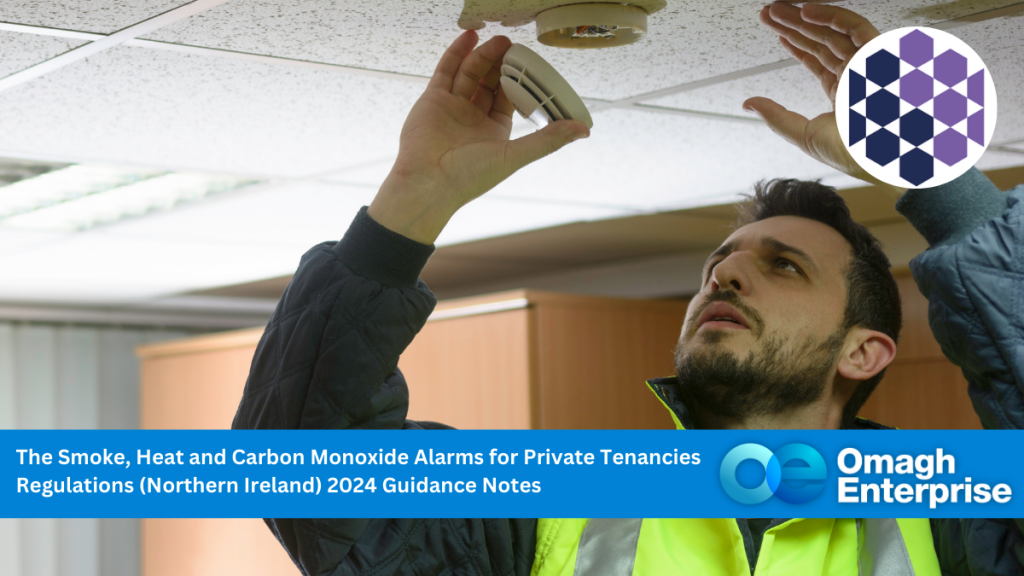These guidance notes have been produced to clarify what is required under the Smoke, Heat and Carbon Monoxide Alarms for Private Tenancies Regulations (Northern Ireland) 2024.
Important dates for compliance
The Regulations come into operation on 1 September 2024, for all new private tenancies granted on or after this date. Existing tenancies granted before 1 September 2024, must comply by 1 December 2024 this means all private rented properties must comply and install the required smoke, heat and carbon monoxide alarms by the compliance dates.
For the purposes of the Regulations, a landlord has ultimate responsibility to ensure the property is compliant, even when someone, such as an agent, has been engaged to act on their behalf.
- The Smoke, Heat and Carbon Monoxide Alarms for Private Tenancies Regulations (Northern Ireland) 2024
Purpose of smoke, heat and carbon monoxide alarms
According to national fire statistics fires in properties that have alarms in place continue to:
- be discovered more rapidly (less than 5 minutes) after ignition; and
- be associated with lower fatal casualty rates.
The installation of smoke, heat and carbon monoxide alarms are intended to reduce the risk of fire and the consequent loss of life, injury, and damage to property. That is why this new legal requirement was introduced under Section 8 of the Private Tenancies Act (NI) 2022.
Landlords’ responsibilities
These Regulations introduce a responsibility on a landlord to install and keep in proper working order sufficient alarms for detecting smoke, heat and carbon monoxide within any property that they rent out to tenants. Alarms need to provide sufficient warning of potential danger. Additionally, any alarm within the property must be repaired or replaced once a landlord has been informed it has become faulty. Section 6 of this guidance details the number, type and location requirements that need to be applied.
A landlord needs to ensure that any alarm units (smoke, heat & carbon monoxide) that are bought/installed are marked/referenced as being British Standard compliant. If any alarms are to be hardwired into the main electrical installation, that work will need to be undertaken by a qualified electrician.
The landlord is responsible for the alarms within their property and must ensure they are fully functional. The landlord should confirm the tenant is satisfied all alarms are in working order on the commencement of any tenancy. The landlord should keep a formal record of when alarms are installed or replaced. It is recommended to keep a record and any further information you hold on your rental property. A copy should also be placed within any information pack located in the property for the tenant’s information. All tenants should be advised they need to regularly test the alarms according to the manufacturer’s instructions, and to report any faults to the landlord. A landlord is not responsible if a tenant fails to take proper care of the alarms and make good any damage wilfully or negligently caused by themselves, or by any person/persons lawfully living in or lawfully visiting the premises.
If the alarms are due to be replaced, or a fault occurs, landlords must take remedial action. Failure to comply may be a breach of their duty under these Regulations and an offence may have been committed. A landlord must check the tenant’s availability to get access to a property to do repairs and maintenance work.
If a situation does occur in respect of access to the property landlords should attempt to understand why tenants cannot or will not provide access and work with them to find a solution. If access is continually denied landlords should write to their tenants to explain that it is a legal requirement to install the alarms and that it is for the tenant’s own safety. Landlords should provide the tenant with a minimum of 24-hour notice for the need to access the property arranging a time to visit that is convenient for the tenant. The landlord should keep a written record of access attempts to provide to the council in case of any challenge in respect of compliance. A landlord can apply to the County Court for an Order of Access if the tenants refuse to allow access for inspection or to carry out works in the property.
Tenants’ responsibilities
If tenants find that their alarms are not in working order during the tenancy, they need to report this to the relevant landlord or letting agent. Landlords will be responsible for repairing or replacing any faulty alarms. However, a landlord must be notified that a fault has occurred. (A landlord is not under a duty to carry out works unless they have actual knowledge of the fault.)
Tenants should refer to the notes section of their tenancy information notice, their tenancy agreement, or any specific tenancy information pack provided by the landlord for any detail on testing and checking alarms.
Additionally it is a tenant’s responsibility to take proper care of the alarms and make good any damage wilfully or negligently caused by themselves, or by any person/persons lawfully living in or lawfully visiting the premises. (Tenants should not tamper with alarms in the property.)
As it is a legal requirement on the landlord to install alarms for the tenants’ own safety, tenants should ensure that any required access to the property to do repairs, maintenance work and install alarms can be accommodated at a mutually agreeable time. If your landlord fails to repair or replace alarm/s or take remedial action you can contact your local Council to report your landlord is failing to comply with their duties.
Tenants have a duty to permit reasonable access to a landlord, or persons authorised by the landlord, to inspect the property and to carry out any necessary work. If a landlord is not granted access, they may apply to the County Court for an Order of Access.
The NIFRS have the following advice in the event of a fire.
Testing alarms to check they are in working order
Testing smoke, heat and carbon monoxide alarms is straightforward and does not require specialist skills or knowledge. Landlords should consider providing tenants with a demonstration and/or instructions to support understanding of how, and when, to test alarms to make sure they are in working order. Tenants should be advised of the expiry dates of the alarms located within the property and warned not to tamper with the alarm units.
Landlords should test the alarms before a tenancy commences and advise tenants to test the alarms once per week by pressing the test button. If they can’t reach, ask a family member or neighbour to help, or use a broom handle. It is the tenant’s responsibility to undertake regular testing of the alarms and inform the landlord of any faults. All relevant information should be included within any information pack located in the property for the tenant’s information.
Requirement for alarms and installation
A landlord must have within the property a minimum of:
One smoke alarm installed in:
- the room which is most frequently used by the occupants for general daytime living purposes (normally the living room/lounge), and
- in every circulation space (halls, stairs, landing or corridor)
- one heat alarm installed in every kitchen
- one carbon monoxide alarm installed in any room or circulation space of the property which contains a flue (including a chimney of an open fire that has not been put beyond use) and/or a fixed combustion appliance other than a gas cooker/gas oven
Alarms must meet the British Standard and be fitted on the ceiling or wall according to the manufacturer’s instructions.
In connection with the standards on the required number of alarms outlined in the Regulations, it is recognised the layout and design of a property may determine that:
- if an area is open plan, one smoke alarm can cover the whole room provided it can be located where it is no more than 7.5 metres from any point in the room, except where the open plan area contains a kitchen area in which case the alarm fitted must be a heat alarm
- if an alarm is more than 7.5 metres from any point in the room then another smoke alarm must be installed
- where the proximity of an open fireplace would make a smoke alarm impracticable a heat alarm may be fitted
Smoke and Heat alarms (mains wired, battery, or a combination of both) must be installed on the ceiling and be interlinked. That means if one smoke alarm detects an incident all other alarms in the vicinity of that first alarm’s signal will also raise an audible alert. These alarms must be installed and maintained in accordance with British Standards BS 5839-6(b).
Carbon monoxide alarms (mains wired or battery) can be either ceiling or wall mounted see section 8.11 for further clarification. If the alarm is battery operated, it must have a sealed battery for the duration of its lifespan. These alarms must be installed and maintained in accordance with British Standards BS EN 50292(c).
If using battery smoke alarms, they must be sealed tamper-proof units and have long-life batteries. You may be able to fit these alarms yourself as they do not need to be fitted by a qualified electrician. Batteries last for the duration of its operational lifespan, which may be up to 10 years however, be aware sensors can degrade over time. Please note battery alarms are not subject to building control approval.
Mains wired alarms (smoke, heat or carbon monoxide) must be fitted by a qualified electrician; it is recommended that the electrician should be registered with a recognised electrical trade body.
Main wired alarms
Please note if mains wired alarms were installed in order to comply with Building Control Regulations, for instance, at the time the property was constructed or extended, then these alarms must not be disabled and if they require replacement, they must be replaced by mains wired alarms to ensure they remain compliant. If a property requires additional alarms to meet the new Private Tenancies Regulations, these additional alarms can be either hardwired, sealed tamper-proof battery alarms or a combination of both. All smoke and heat alarms (both pre-existing and new/additional) must interlink.
Communal areas
The Private Tenancies Regulations do not cover alarms located in communal or common areas within an apartment block or flats, these areas are subject to Building Control Regulations and appropriate advice should be sought. For further information please check the following link.
Fire safety checks
Northern Ireland Fire and Rescue Service provide free Home Fire Safety Checks to people at risk. This includes a visit to the property to provide advice on how to stay safe from fire. To apply for a Home Fire Safety Check and get additional advice, please visit the NIFRS website.
Where photovoltaic solar panels are fitted, with battery storage or other associated equipment, installed in an attic, loft or ceiling void, it is recommended that additional smoke detection be installed above the items following the recommendations of British Standard 5839-6.
Specialised alarms
It is recommended as good practice that landlords should make an informed decision and choose the best alarms for their properties and tenants, with due regard for their tenants’ circumstances. For example, specialist smoke, heat, and carbon monoxide alarms that alert by vibration or flashing lights (as opposed to sound alerts) may be required for tenants who are deaf or have a hearing impairment.
Carbon monoxide alarms
Carbon monoxide (CO) is a gas, produced when carbon-based fuel, such as coal, wood, oil, or natural gas is burnt without enough oxygen. You cannot see, smell, or taste it but it can injure and kill quickly. Not only is CO responsible for many deaths and poisonings each year, but many people are also likely to be affected by CO without realising it.
Alarms are essential in providing perhaps the only warning an occupier will have of the presence of CO, which is a ‘silent killer’ and almost every fatality results from the lack of early warning to its presence.
Fixed combustion appliances such as boilers, fires (including open fires), heaters and stoves fuelled by solid fuel, oil or gas all have the potential to cause CO poisoning if they are poorly installed or commissioned, inadequately maintained, or incorrectly used. Inadequate ventilation or a lack of the correct maintenance of appliances, flues and chimneys are the main causes of CO poisoning. Poisonous CO gas is produced when fuel does not burn properly. Incidents of poisoning can also occur through deterioration of the structure of the flue or chimney.
The installation of carbon monoxide alarms is intended to reduce the risk of CO poisoning and the consequent loss of life and serious injury. These Regulations match the existing Regulations required for new build properties. The Building Regulations (Northern Ireland) 2012. Private landlords must ensure that all the properties they let to tenants include carbon monoxide alarms, if appropriate, regardless of when the tenancy started and what previous requirements have already been met.
Tenants have a right to refer any landlord not complying with the installation of carbon monoxide alarms or any other element of non-compliance within the Regulations to the environmental health department of their local council.
In order to alert occupants to the presence of levels of CO gas which may be harmful to people, private landlords must ensure that carbon monoxide alarms are installed in all dwellings they rent to tenants where there is:
- a fixed combustion appliance (excluding an appliance used solely for cooking eg gas cooker/gas oven) in the dwelling
- a fixed combustion appliance in an inter-connected space, for example an integral garage
- a fixed combustion appliance necessarily located in a bathroom (advice would be to locate it elsewhere) – the CO detector should be sited outside the room as close to the appliance as possible but allowing for the effect humid air might have on the detector when the bathroom door is open
- a room or bedroom where a flue passes through. (A flue is a pipe or channel for conveying exhaust gases from a fixed combustion), eg from an open fire, wood stove oven, furnace, boiler, or steam generator
- if a chimney or flue on the fireplace is blocked off and cannot be used, a carbon monoxide alarm would not be required
A carbon monoxide alarm is required for an integral garage that is built within the walls of the property and is structurally connected and can be accessed via an internal door or from outside the property.
A carbon monoxide alarm is not required in a detached out-building or garage where there is no connection with the house. To be clear, if there is no way that CO could reasonably be expected to find a path into the house there is no need for a detector.
Carbon monoxide alarms need to be powered by a battery designed to operate for the working life of the detector. The detector should incorporate a warning device to alert the users when its working life is due to expire and should be replaced before the expiry date. However, hard wired mains operated carbon monoxide alarms (fixed wiring) may be used as an alternative, provided they are fitted with a sensor failure warning device. Carbon monoxide alarms whether hard-wired or battery must be British Standard compliant.
Unless otherwise indicated by the manufacturer, carbon monoxide alarms should be positioned as follows:
- ceiling mounted and positioned at least 300mm from any wall (unless otherwise indicated by the manufacturer)
- wall mounted and positioned at least 150mm below the ceiling and higher than any door or window in the room (unless otherwise indicated by the manufacturer)
- if the fixed combustion appliance (primarily boiler) is located within a small space, usually a cupboard, the alarm should be sited outside the space/cupboard with the appropriate distance between appliance and alarm of between one and three metres
- if the fixed combustion appliance (primarily boiler) is located in an attic, the detector should ideally be sited between one and three metres from the appliance in the attic and another detector sited outside the attic near the attic hatch. Where this is not possible, a detector sited outside the attic as near the attic hatch as possible is acceptable. It is recommended that if you have more than one carbon monoxide alarm, they are interlinked to each other. (NOTE: This is a not a legal requirement under the Regulations)
A carbon monoxide alarm should not be sited:
- in an enclosed space (for example in a cupboard or behind a curtain)
- where it can be obstructed (for example by furniture)
- directly above a sink
- next to a door or window
- next to an extractor fan
- next to an air vent or similar ventilation opening
- in an area where the temperature may drop below -10°C or exceed 40°C unless the detector is designed to do so
- where dirt and dust may block the sensor
- in a damp and humid location
- in the immediate vicinity of a cooking appliances
Landlords should be mindful that the provision of carbon monoxide alarms should not be regarded as a substitute for the correct installation and regular servicing of all fixed combustion appliances.
Although not part of these Regulations further information relating to Gas Safety can be found via the following link.
Enforcement
If a landlord fails to comply with the duty to keep in repair and proper working order sufficient appliances for detecting smoke, heat, and carbon monoxide in a private tenancy, this will be an offence under Article 11B(4) of the Private Tenancies (NI) Order 2006 and the council may instigate legal proceedings.
Fines/penalties
If the council believes that an offence has been committed the authorised council officer may offer the landlord the opportunity of discharging any liability to conviction by the payment of a fixed penalty fine which will not exceed one-fifth of the maximum fine payable on conviction of that offence.
If you have any queries about this guidance, please contact the team at Private Rented Branch.




